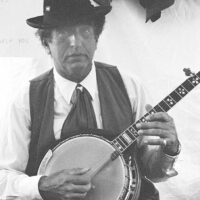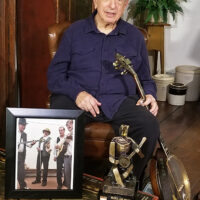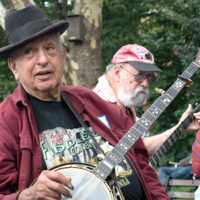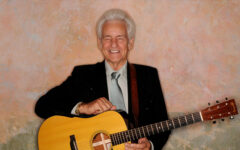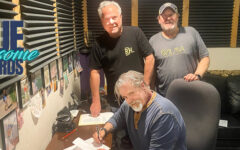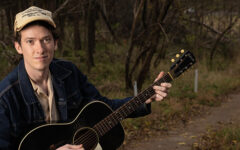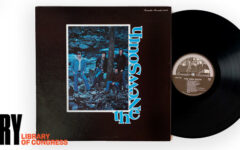
Roger Sprung, the innovative five-string banjo player, popular instructor and successful instrument dealer, widely recognized as “the Godfather of Progressive Bluegrass,” and a pioneer of newgrass, passed away in Newtown, Connecticut, where he had made his home for many years. He was 92 years old.
Born on August 29, 1930, the son of Manhattan attorney Sam Sprung and wife Peggy, Roger was drawn to music as a boy.
At about age five, he was started in music by a nanny who taught him the fundamentals of piano. Little Roger was soon putting together rudimentary but complete tunes to perform. He eventually took piano lessons and found joy in boogie woogie.
Then, in 1947, when Roger was still in his teens, elder brother George took him downtown to Washington Square Park in the Greenwich Village neighborhood of New York City, where a Sunday afternoon folk music scene was blooming.
Roger looked and listened in wonder at (as he once recalled), “people of all ages playing all kinds of stringed instruments and things. And I thought, ‘That’s for me!’ ”
A grandfather who owned a pawnshop provided him with a guitar. Soon Roger acquired a five-string banjo and set about learning to play it in the manner of other early Yankee devotees of bluegrass: slowing down records (in Roger’s case, 78s by Lester Flatt, Earl Scruggs & the Foggy Mountain Boys) and painstakingly deciphering the picking patterns.
Prominent folksinger/banjo player Pete Seeger and “classical style” banjoist Paul Cadwell were also early influences, broadening Sprung’s appreciation of the banjo’s eclectic possibilities. (Later, Roger became a prominent banjo teacher himself with innumerable students over the decades, including many who went on to professional performing careers.)
Early on, he made serious forays down to the Carolinas and Virginia to learn traditional music at its source. A marker of Roger Sprung’s role as a true Northern pioneer in the propagation of traditional-style Southern string band music is this: In 1950 — now nearly three-quarters of a century ago — he made the first of numerous trips with mandolinist Harry West, a fellow New Yorker and Southern music fan, to Ashville, North Carolina. The tunes and techniques he learned at the feet of such old-timey banjo masters and musical tradition preservers as Samantha Bumgarner and Bascom Lamar Lunsford he soon shared with fellow Yankees. (During these pilgrimages to the source, Roger also became adept at the old-time clawhammer or frailing style of banjo.)
The Washington Square jams ramped up New York’s role in the Folk Revival. Roger — grown into a stalwart young six-footer, exuding confidence and authority on the banjo — became the pillar of many a bluegrass and old-timey session. Indeed, writer Ralph Lee Smith has declared: “Banjo player Roger Sprung almost single-handedly introduced Southern bluegrass music to New York through his playing in Washington Square.” And the Folksay Trio, the Shanty Boys, and his other early ensembles have entered the lore of the vibrant folk revival.
Soon, musicians from the Southern heartland were traveling north to perform in New York. Among the most notable was singer and guitar virtuoso Arthel “Doc” Watson of North Carolina. Roger invited him to be part of an upcoming Folkways Records session. These were Doc’s first studio recordings and one of the first collaborations between northern and southern greats of “mountain music.”
The resulting album, Progressive Bluegrass Volume 1, was also a landmark for Sprung’s evolving style and repertoire, with cuts of Stars and Stripes Forever, Mack The Knife, and Greensleeves. The album’s finale Bye Bye Blues remains a thrilling track in which Doc and Roger inspire each other to new musical heights.
Subsequent Sprung albums on Folkways featured now well-remembered New York City pickers Jon Sholle (guitar) and Jody Stecher (mandolin). The Sprung repertoire encompassed banjo arrangements of Elizabethan airs; compositions by Mozart, Stephen Foster and Kurt Weill; pop hits like Mrs. Brown You’ve Got a Lovely Daughter, Hello Dolly, and other Broadway show tunes; joyous international dance numbers like Hava Nagila, Jingle Bells, and other holiday favorites like Jingle Bells.
But Roger never strayed far from folk music done bluegrass-style. One of his most popular albums was Roger & Joan with his first wife, Joan (Sachs) Sprung, a Morristown, New Jersey-raised folk singer/guitarist/songwriter.
And he had a special love for the British Isles traditional music that provided the taproots for so much of the later flowering of American old-time and bluegrass.
Starting in the 1970s, he began an especially fruitful collaboration with guitarist/vocalist Hal Wylie. Although a Bronx-born bluegrass/old-timey player, Hal had a gift for singing British broadsides, sea chanteys, and Irish ballads. Roger began billing his group as Roger Sprung, Hal Wylie & the Progressive Bluegrassers. (Hal passed on September 20, 2014.)
Roger’s memorable performance style evolved along with his music, notably his jaunty stage attire of white dress shirt, black slacks, red vest, and black and white brogue shoes, all topped by a homburg hat. The outfit was so “Roger,” an eye-catching visual well-suited to his first national entertainment forays of the late 1950s and early ’60s, which included tours with cabaret singer Kay Starr, appearances on the TV variety programs of Dean Martin, Garry Moore, and Jimmy Dean, and (in later years) concerts at Carnegie Hall and Lincoln Center.
Roger’s trademark homburg had deep significance: The hat had belonged to his dad, and he wore it to honor the father who was so proud of his son’s successful non-traditional career in traditional music.
The Sprung band played numerous bluegrass gigs in the South, notably for promoters Carlton Haney and Jim Clark during the mid-1970s to 1980s early heyday of the festival movement. Roger was also a familiar fixture at such gatherings behind his busy instrument sales table. And none other than Bill Monroe — the Father of Bluegrass himself — thought so highly of his music that if they played the same festival, Roger was often invited onstage to pick a few numbers with the Blue Grass Boys.
Roger also established much of his reputation at folk and old-timey festivals, notably with multiple appearances at the Union Grove, North Carolina, and Galax, Virginia, fiddlers conventions, and the Philadelphia Folk Festival, held in Paoli and Upper Salford, Pennsylvania. Roger’s band also played concerts extensively in the Mid-Atlantic and New England.
Roger’s personal banjo was a 1927 Gibson Mastertone. Like a hot rod racing car, it was an amalgamation from different parts sources, tricked out with high-performance extras. Never shy about pushing the envelope — or turning a peg — he installed Keith-style tuners for all his banjo strings (including the high drone “fifth”). These were brought into flamboyant play during his showcase rendition of Home, Sweet Home.
Speaking of which … Roger established a cherished home in Newtown, Connecticut, where he and his family kept a happy menagerie of some 45 animal friends: dogs and cats; donkeys, ducks and goats; even ferrets and a miniature pig. For enjoyment, he created superb pen-and-ink drawings. (Friends who received his cards and letters marveled at his beautiful copper plate engraving-quality handwriting.) He also initiated a monthly local jam session which ran for nearly 25 years.
In evaluating Roger Sprung’s place in bluegrass history, it can be noted that he was not the first five-string great to think (and pick) outside the box of standard material. Pete Seeger included a banjo arrangement and virtuoso performance of the Irving Berlin standard Blue Skies on his 1955 album, Goofing Off Suite; Don Reno brought jazz chording and even rockabilly rhythms to his five-string picking in the late ’50s and early ’60s; and even Earl Scruggs was jazz-influenced, with his 1950s recordings of Farewell Blues and Bugle Call Rag having started as 1920s jazz compositions that Earl reinvented as bluegrass banjo standards.
And starting in the 1970s there were the Southern-born exponents of “newgrass” (notably members of the New Grass Revival, the band that helped name the genre). They similarly thrived on innovation and inspiration, and also faced the skepticism of some bluegrass traditionalists.
But Roger Sprung has a firm and, it can be argued, unique place in bluegrass history. In a message sent to a September 14, 2019, tribute to Roger in Oxford, Connecticut, banjo picker and Nitty Gritty Dirt Band co-founder John McEuen emphasized that Sprung revealed “playing directions I had not thought to explore. His border-crossing explorations – like those of Reno and Adcock – brought me and many others to a new path to head down.”
And the prizes won and accolades earned by Roger during his seven decade-long career also put him firmly among the greats of bluegrass and old-time music.
He garnered the title “World Champion Banjo Player” at the 1970 Old Time Fiddler’s Festival at Union Grove, NC with a rousing performance of the traditional tune, Whiskey Before Breakfast; was honored as a “Pioneer of Bluegrass” by the International Bluegrass Music Association in 2009; and was named to the American Banjo Museum Hall of Fame in 2020.
In particular, Roger Sprung launched a two-barreled blast of helping introduce multitudes of musicians and listeners outside the South to bluegrass five-string banjo, while also hugely expanding the possibilities of what could be played on the instrument.
As wife Nancy relates: “Roger told me that bluegrass is a style of music, and that you can play any song in the bluegrass style.”
He is survived by Nancy (to whom he was married 33 years) and their daughters Jennie and Emily.
R.I.P., Roger.
